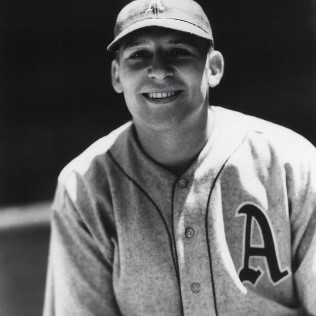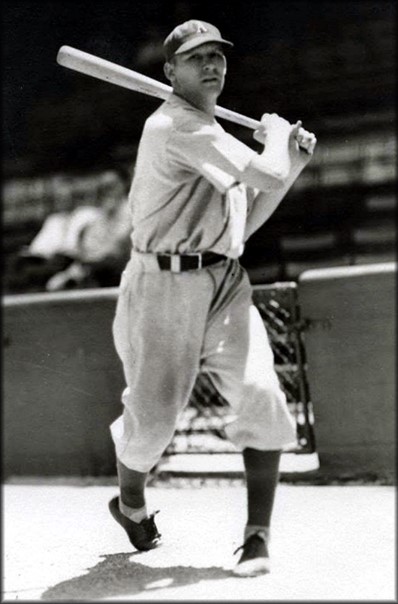Visits: 15
 Over one thousand Major League Baseball players served in the US military during World War II. Yet despite this large number – and in spite of both the ferocity and length of the war – only two of those ballplayers were killed in action during World War II. Their names were Elmer Gedeon and Harry O’Neill.
Over one thousand Major League Baseball players served in the US military during World War II. Yet despite this large number – and in spite of both the ferocity and length of the war – only two of those ballplayers were killed in action during World War II. Their names were Elmer Gedeon and Harry O’Neill.
While we honor the sacrifice made by Gedeon, this post in particular remembers the notable life, career and service of Harry O’Neill.
Young Athlete to College Star
Harry O’Neill was born on May 8, 1917 in Philadelphia. He was an athletic kid, growing into a productive multi-sport athlete at Darby High School and Malvern Prep School. After High School, he attended Gettysburg College in Pennsylvania.
O’Neill played three collegiate sports while at Gettysburg. He was the center on the football team, center on the basketball team, and catcher on the baseball team. O’Neill helped each of these teams win at least one conference championship during his college career, even leading the basketball team in scoring during his final two years. Needless to say, his college resume and large build (6 foot 3, 205 pounds) made him a hot commodity approaching graduation in 1939.
Career in the Big Leagues
 At the time, rumor had it that O’Neill might sign with the Washington Senators after graduating. Instead, he chose to play for his hometown Philadelphia Athletics, led by Hall of Famer Connie Mack. He was signed by the A’s for a salary of $200 per month.
At the time, rumor had it that O’Neill might sign with the Washington Senators after graduating. Instead, he chose to play for his hometown Philadelphia Athletics, led by Hall of Famer Connie Mack. He was signed by the A’s for a salary of $200 per month.
Interestingly, O’Neill never played in the minor leagues. Instead, he immediately became Philadelphia’s third-string catcher, spending most of the summer catching in the bullpen. He didn’t see any action until July 23, 1939, in a game against the Detroit Tigers. O’Neill entered the game in the eighth inning as a defensive replacement, never getting an at bat. The A’s lost the game by a score of 16 to 3.
That was the only game O’Neill would play in the majors – he was released by the A’s in September.
Following his release, O’Neill took a job as a teacher and coach at Upper Darby Junior High School. However, he attempted a comeback in the summer of 1940 when O’Neill signed with a minor league baseball team named the Harrisburg Senators. He played only 16 games with the Senators, ending the season with a .238 average. He was released at the end of the season.
Serving His Country
On December 7, 1941, the Japanese attacked Pearl Harbor, prompting the US to join in the Second World War. Like many American men of the time, O’Neill decided to serve his country by enlisting in the Marine Corps.
After finishing Officer Training School, he continued stateside training for a period before he got orders to ship out in January 1944. O’Neill was a first Lieutenant by this time, serving with the famous 4th Marines.
Once in the Pacific, he saw action at the bloody battles of Kwajalein, Tinian and Saipan. During the Battle of Saipan, he received a shrapnel wound which forced him back to the states to receive medical treatment. For this wound, he received the Purple Heart.
O’Neill soon found himself in battle once again. In February 1945, the US assaulted a little known island called Iwo Jima, which turned out to become one of the bloodiest battles of the war. After the amphibious assault, the Marines slowly worked through the interior of the island, fighting a very determined enemy. A little over two weeks following the initial landing, O’Neill was a part of an assaulting force when he was shot by a Japanese sniper. He died instantly.
He was initially buried on Iwo Jima, but two years after the war ended O’Neill’s remains were moved to a cemetery closer to his home in Pennsylvania. He left behind a wife, named Ethel.
Remembering O’Neill
Although Harry O’Neill only had a brief career as a big league ballplayer, his legacy lives on as a man who gave the ultimate sacrifice to his country. In the span of professional baseball history, only a handful of such men have died fighting for their country, while an exponentially larger number had their baseball careers stalled – some irreparably – in the prime of their lives. It is right and fitting to honor such men. Baseball’s heritage is that much stronger with them having been a part of it.
Sources
There is some very good source material in existence covering the life of Harry O’Neill. This material, of which I reference throughout this post, includes the following:
- Harry O’Neill, by Baseball’s Greatest Sacrifice (URL)
- Harry O’Neill, by Baseball in Wartime (URL)
- Harry O’Neill, by the Society for American Baseball Research (URL)
- Harry O’Neill ’39: A Legend Lives On, by Gettysburg College (URL)
- Harry O’Neill ’39 Remembered, by Gettysburg College (URL)
- “Two Who Did Not Return”, by Robert Weintraub for The New York Times (URL)



You must be logged in to post a comment Login